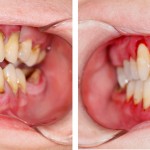
Periodontal disease is common and with increased retention of teeth and an ageing population the disease burden is likely to increase.
The aim of this study were (i) to determine prognostic factors of tooth loss in a compliant cohort of patients under a conservative periodontal treatment concept and (ii) to describe long-term trajectories of bone loss (BL) and pocket probing depths (PPD).
Methods
A longitudinal study of 2564 patients with moderate to advanced periodontitis treated between 1982 and 1998 followed a conservative regimen according to the treatment guidelines of the Department of Periodontology, Christian-Albrechts-University of Kiel, Germany. Patient data was held on a specially developed database.
Only patients who had received supportive periodontal treatment (SPT) for ≥9 years with ≥1 visit/year including an annual documentation of PPD as well as a complete radiographic documentation at T0 and at the last documented visit of SPT (T2) were considered. A tolerance of ± 2 years was accepted for radiographic examination. Patients with aggressive periodontitis were excluded.
315 patients were examined before (T0) and after active periodontal therapy (APT, T1) as well as after supportive periodontal therapy (SPT, T2). Active periodontal therapy(APT) included non-surgical, mechanical root debridement (scaling and root planing, SRP) with, if indicated, additional access flap surgery. SPT included plaque revelation re-instruction and re-motivation including brushing demonstration, professional tooth cleaning and SRP of residual pockets, followed by polishing and fluoride application and if necessary further treatment including non-surgical SRP alone or open flap debridement with or without subsequent systemic or local antibiotic therapy.
Annual records of medical history and self- reported smoking status were available. Teeth lost during APT (T0–T1) and SPT (T1–T2) were documented. Regression analysis was conducted to assess prognostic factors
Results
- 315 patients were included (male: 136/43.2%, female: 179/ 56.8%)
- At baseline 8009 teeth were present (maxilla: 3849, mandible: 4160)
- All patients received the described conservative periodontal treatment
- 29 (9.2%) patients received antibiotic therapy for APT , 5 for both APT and SPT.
- The mean duration of
- APT = 1.41 ± 0.70 years.
- SPT =18.3 ± 5.7 years (range: 9–31)
- Tooth loss during APT = 351 and SPT = 861
- More teeth had to be removed in the maxilla than in the mandible (18.5% versus 11.3%)
- In the first 14 years of SPT, the annual extraction rate remained nearly stable (0.57%/year), while the variability of the annual extraction rate increased in the late SPT period.
- After APT, the proportion of surviving teeth with PPD > 6 mm decreased from 17.2% to 1.6% and remained stable (1.7%) until T2. Parallel to this, the proportion of teeth with non-pathological PPD (<4 mm) increased from 24.6% to 73.3% and remained high (68.6%) during SPT.
- Age, bone loss, higher PPD at T1 and smoking were identified as prognostic factors for tooth loss.
Conclusions
The authors concluded
The present study confirmed that long-term tooth retention is possible in patients with periodontitis using a non-regenerative treatment concept. A number of prognostic factors like patients’ age, smoking status, PPDs and BL can be used for individualised treatment planning. As only a minority of patients experience the majority of tooth losses, discriminating these patients from those were tooth retention is likely feasible is important to prevent premature tooth removal.
Comments
This interesting longitudinal study with a relative long follow up period suggests that conservative non-regenerative periodontal therapy can results in long term tooth retention in patients with moderate to advanced periodontal disease. However, as the authors point out only compliant patients were included and patients with aggressive periodontal disease were excluded. While the authors endeavoured to identify the reasons for tooth loss it was not always possible to the data for tooth loos included loss from any cause. The study also found that only a small group of patients lost a majority of teeth a finding which has been noted in other studies. Data on tooth loss over time is likely to be of interest to patients but the current study does not allow comparison of different treatment regimes or impacts on less compliant patient groups.
Links
Primary paper
Graetz C, Plaumann A, Schlattmann P, Kahl M, Springer C, Sälzer S, Gomer K, Dörfer C, Schwendicke F. Long-term tooth retention in chronic periodontitis – results after 18 years of a conservative periodontal treatment regimen in a university setting. J Clin Periodontol. 2016 Dec 27. doi: 10.1111/jcpe.12680.[Epub ahead of print] PubMed PMID: 28028838.
Other references
Dental Elf – 31st Mar 2015
Periodontal disease: compliance with treatment improves outcomes
Dental Elf -3rd May 2013

[…] post Periodontal treatment: outcomes from long-term conservative management appeared first on National Elf […]
[…] Periodontal treatment: outcomes from long-term conservative management […]